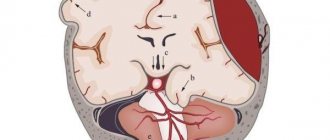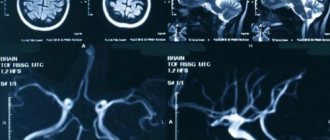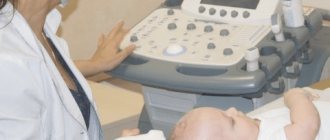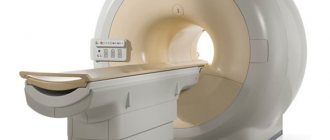Neurodegenerative diseases of the brain
Neurodegenerative diseases include a whole group of diseases that are based on processes that destroy brain cells. Diseases may differ in symptoms, duration, and lesion site, but they are all united by dementia (dementia, personality destruction), which is an invariable companion to all neurodegenerative diseases of the brain.
All diseases included in this group lead to complete degradation of personality, dementia as a result of the death of brain cells. This process is irreversible, and the main task facing the doctor is to stop the process. Dementia manifests itself differently with each individual disease, to varying degrees and at different stages, but the result, as a rule, is the same - personality degradation and death from somatic diseases.
All neurodegenerative diseases of the brain manifest themselves at different ages and are not a sign of extreme old age.
Let's list some of the most common diseases of this type: Alzheimer's disease. This disease is popularly known as “senile insanity.” However, this disease is not a disease of old age; it can develop at the age of 40 or even earlier. The initial stage is often mild, so the onset of the disease can be missed. Over time, memory problems intensify, thinking and perception, speech suffer, and vision and hearing may also suffer.
Parkinson's disease . This disease is known for the fact that the patient suffers from severe tremors, his hands and head shake, he cannot move normally and hold objects. Most often, this disease occurs in older people over 60 years of age. In addition to movements, speech suffers, masticatory muscles weaken, and drooling occurs.
Pick's disease. It is also more common in older people. Some areas of the brain atrophy, leading to dementia and various disorders. This disease is characterized by signs of dementia in the earliest stages. The disease progresses rapidly. The average life expectancy for Pick's disease is 6 years.
Dementia with Lewy bodies. Lewy bodies are a specific protein that accumulates in brain cells, causing their death. Symptoms are similar to Parkinson's disease. The disease progresses, but is accompanied by rare improvements. Within each individual disease, there may be different stages, degrees, forms of dementia, and localization of brain lesions.
Permanent symptoms of neurodegenerative brain diseases are signs of dementia. They are the ones who give a signal about some pathological processes in the brain. At first, a person’s memory is impaired, he forgets names, confuses dates, cannot remember where he put his wallet or whether he walked the dog, but criticism and consciousness are still normal. At this stage, you can mistake dementia for ordinary absent-mindedness, which is characteristic of many people and not only in old age. Over time, the patient’s intelligence begins to decline, spatial orientation is impaired, habitual skills are lost, the person has difficulty using household appliances, and does not admit his lack of independence, that is, criticism weakens.
The last stage of dementia is the complete collapse of personality. For the family, the patient is seen as a completely insane person who does not recognize anyone. Any communication with the patient becomes almost impossible. A person needs constant care and supervision. Then, as a result of somatic diseases, death occurs. The causes of neurodegenerative diseases can be various processes and factors. They do not always depend on heredity or injury.
Key causes of neurodegenerative diseases:
Vascular diseases. Problems with blood vessels can lead to insufficient nutrition of the brain. With serious vascular diseases, brain cells gradually begin to die. However, this process can in some cases be stopped if the underlying cause is treated.
Genetic predisposition. Some diseases have their own gene, for example, there is a test that shows a predisposition to Alzheimer's disease, which is offered to those who have relatives with this disease.
Traumatic brain injuries . As a result of trauma to the brain, one of the possible consequences is dementia.
Brain cancer. Tumors can form in various lobes and areas of the brain, but they are all accompanied by neurological changes, including blindness, deafness, memory and thinking disorders, and personality degradation.
Infections. Various serious infections such as encephalitis, syphilis, HIV also sometimes lead to the destruction of brain cells.
Diagnostics Methods for researching neurodegenerative diseases of the brain Diagnosis of neurodegenerative diseases of the brain is complicated by the fact that there is no analysis or examination that would accurately and quickly indicate a specific diagnosis. Of course, diagnostics may include a blood test, an MRI, and an electroencephalogram. This is especially true for traumatic brain injuries.
MRI shows whether there are tumors in the brain, whether there are problems with blood vessels, hemorrhages and any changes.
A blood test helps to find out if you are anemic or if there are any changes in your blood cells.
If a person suspects signs of dementia in himself or his family member, he should be examined by a neurologist, therapist and ophthalmologist, and also visit a psychiatrist. Very often, the onset of a neurodegenerative disease can be confused with severe depression, when memory also deteriorates, problems with communication and perception begin, and a person has difficulty finding words. This severe depression can develop after shock, trauma or stress. To make a diagnosis, in addition to passing all the tests, it is necessary to observe the patient for six months. If during this time the same symptoms persist or worsen, we can talk about dementia.
Signs of a neurodegenerative disease also include hearing impairment, sometimes hallucinations and delusions, and the presence of organic brain damage (hemorrhage, tumor). During the examination, the patient undergoes several tests for perception, memory, logical and abstract thinking. For example, a doctor asks a patient to remember 3 words that are unrelated to each other in meaning, for example, “chair, sky, anger.” Then they are asked to draw a clock face and write the numbers next to it. After some time, the patient must repeat the words. These tests may be done at regular intervals over several months to see how quickly the disease is progressing.
Lumbar puncture is also used as a diagnostic tool. A small amount of cerebrospinal fluid is taken from the patient through a small puncture in the lower back. It is used for examination and further diagnosis of the body’s condition, and thus reduces intracranial pressure. Such a study will help identify the presence of serious infections, hemorrhages in the brain, and various tumors.
Treatment . Treatment of neurodegenerative diseases has its own characteristics: At the same time, it is necessary to treat somatic diseases. Patients require constant care and support. It is not recommended to leave them alone and isolate them from society, as this will only worsen the course of the disease. Social support and psychological assistance are an indispensable part of comprehensive treatment. Drug treatment depends on the specific disease and the cause of its occurrence. For example, in case of vascular dementia, medications are necessarily prescribed to strengthen blood vessels and normalize blood pressure. Also, for neurodegenerative diseases, nootropics (to improve brain nutrition) and antipsychotics (sedatives) are prescribed. Depression often accompanies dementia. In Parkinson's disease, at a certain stage, suicidal tendencies arise. For this reason, antidepressants are prescribed for neurodegenerative diseases. However, these drugs have many side effects. They are selected and adjusted as treatment progresses. In the initial stages, it is important to maintain a certain mental load. Patients perform various exercises to train memory and thinking. This helps slow down the progression of the disease. It is important to monitor the patient's diet. Neurodegenerative diseases are accompanied by various disorders of the digestive and excretory systems; patients' appetite worsens, and bulimia may develop. If this is a bedridden patient, he must be fed on time, excluding foods that can cause intestinal obstruction.
It is impossible to insure yourself against neurodegenerative diseases, but you can reduce the risk of their occurrence or slow down their development: Study foreign languages. It sounds strange, but polyglots are less likely to suffer from neurodegenerative diseases, or they appear later. Maintain your level of physical and mental activity for as long as possible. Physical inactivity causes problems with blood vessels, which can impair brain nutrition and lead to dementia. Intellectual activity is also important. It has been proven that educated people with high intelligence, even if they suffer from neurodegenerative diseases, they begin to appear later, since the functions of dead brain cells are transferred to other cells. Fight diseases that lead to dementia. Risk factors include diabetes, obesity, and alcoholism. All of these conditions need to be treated and monitored to reduce the risk of neurodegenerative diseases. With so many symptoms, neurodegenerative diseases can be complicated already at the initial stages by various conditions and disorders. For example, insomnia. It does not affect everyone or at every stage, but sometimes people with advanced dementia cannot sleep normally at all or sleep during the day and wander around at night. One of the complications is aggression. Some patients may become aggressive, perceiving doctors and family members as a threat. Hallucinations also provoke aggression. This can be observed more often in Pick's disease and alcoholic dementia. Hallucinations are serious complications that cause many problems for both the patient and his family members. Hallucinations, unlike illusions, occur without any external influences. The patient sees something that is not there and perceives it as reality. Hallucinations can be very frightening, the patient screams and experiences extreme stress. This complication occurs in dementia with Lewy bodies. In the initial stages of the disease, it can be complicated by depression, when a person understands that he is sick and what this will lead to.
Clinical symptoms of multiple system atrophy
Diffuse neurodegeneration is accompanied by problems in the reproductive and urinary areas. Necrosis of many parts of the brain is simultaneously accompanied by a variety of clinical symptoms:
- Muscle tremors in Parkinsonism;
- Impaired gait and mobility coordination;
- Loss of erection;
- Vegetative-vascular disorders.
Before the advent of magnetic resonance imaging, early diagnosis of the disease was problematic. Only nuclear magnetic resonance verifies a decrease in the thickness of the brain parenchyma.
Principles of diagnosing atrophy
The initial stage involves taking an anamnesis, examination, and physical examination. The second stage is clinical and instrumental methods (ultrasound, CT, MRI of the brain, scintigraphy, PET/CT). Damage to the optic nerve is confirmed by ophthalmoscopy, tonometry, contrast CT or MRI angiography.
The best way to detect pathology of the soft tissues of the brain is MRI. The procedure must be performed several times (a month apart) to identify atrophy of varying depth and extent.
Magnetic resonance examination reveals the smallest local lesions and helps to correctly determine the degree of disease progression.
Clinical symptoms of brain atrophy
The manifestations of pathology are largely determined by the causes and provoking factors. Most older people have dementia, frontal lobe syndrome, and internal multiple organ pathology.
How does frontal lobe syndrome manifest?
- Lack of appetite;
- Loss of memory, intellectual activity;
- Frequent emotional breakdowns;
- Lack of communication with surrounding people;
- Irritability;
- Lack of self-criticism.
Psychoorganic syndrome is accompanied by cerebroasthenic disorders, affective disorders, and amnesia.
The patient lacks an adequate assessment of surrounding events and self-criticism. Primitive thinking appears, a one-sided representation of the essence of the detail. Speech reserve decreases, paramnesia appears.
Concomitant affective disorders lead to depressive syndrome and inadequate mental state. Tearfulness, touchiness, irritability, unreasonable aggression are typical manifestations of pathology.









